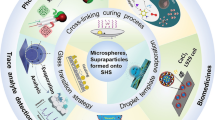Abstract.
A quartz crystal microbalance (QCM) was used to study the adhesion behavior of supramolecular aggregates at supported planar bilayers (SPBs). The QCM technique is a suitable method to detect the adsorption of biomolecules at the quartz surface owing to its sensitivity for changes in mass and viscoelastic properties. To simulate biomembranes, the quartz plates were coated with highly ordered lipid films. Therefore, a combination of self-assembled monolayers and Langmuir-Blodgett films was used. Firstly, the adsorption of liposomes coupled with the lectin concanavalin A was investigated at glycolipid-containing model membranes. Using different carbohydrates, it was possible to determine specific and nonspecific parts of the interactions. The adhesion occurred owing to specific lectin-carbohydrate interactions (about 20%) and to nonspecific interactions (about 80%). The composition of the liposomes was changed to simulate the structure of a native biomembrane consisting of the glycocalix, the lipid-protein bilayer, and the cytoskeleton. An artificial glycocalix was created by incorporating poly(ethylene glycol) into the liposomes. Liposomes which were intravesicular polymerized with polyacrylamide or polyacrylcholate simulated the cytoskeleton. It was determined that the modified liposomes had significant lower interactions with SPBs. The adsorption was reduced by approximately 80% compared to unmodified liposomes. Secondly, a model was developed for the detection of interactions between simple or mixed bile salt micelles and model membranes. It was found that simple bile salts did not adsorb at model membranes. Binary systems consisting of bile salt and phospholipid induced only small interactions. On the other hand, ternary systems consisting of bile salt, phospholipid, and fatty acid showed strong interactions. A dependence on the chain length of the fatty acid was observed. Thirdly, the interaction between ganglioside-containing model membranes and cholera toxin (β-subunit) was investigated. Different ganglioside fractions showed varying adsorption in the following sequence: GM1>GD1a>GD1b>GT1b.
Similar content being viewed by others
Author information
Authors and Affiliations
Additional information
Revised version: 1 December 2000
Electronic Publication
Rights and permissions
About this article
Cite this article
Liebau, M., Hildebrand, A. & Neubert, R. Bioadhesion of supramolecular structures at supported planar bilayers as studied by the quartz crystal microbalance. Eur Biophys J 30, 42–52 (2001). https://doi.org/10.1007/s002490100133
Received:
Accepted:
Issue Date:
DOI: https://doi.org/10.1007/s002490100133




